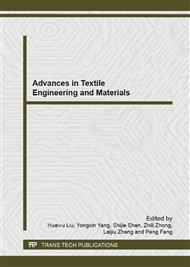[1]
Z.X. Wang, Q.Shen, Q.F.Gu. Preparation and characterization of persimmon leaves/cellulose blend fiber and comparison with cellulose fiber. Carbohydr. Polym 2004; 57: 415-418.
DOI: 10.1016/j.carbpol.2004.05.017
Google Scholar
[2]
K.C. Seavey; W.G. Glasser. Continuous cellulose fiber-reinforced cellulose ester composites. II. Fiber surface modification and consolidation conditions. Cellulose 2001; 8: 161-169.
Google Scholar
[3]
P.D.asquini, E.M. Teixeira, A.A.S. Curveloa , Belgacem M.N, Dufresne A. Surface esterification of cellulose fibres: Processing and characterisation of low-density polyethylene/cellulose fibres composites. Compos. Sci. Technol.2008; 68:193–201.
DOI: 10.1016/j.compscitech.2007.05.009
Google Scholar
[4]
L.C.V. , M.O., Wielena Stenson, Gatenholm P, Ragauskas A.J. Surface modification of cellulosic fibers using dielectric-barrier discharge. Carbohydr. Polym 2006; 65:179–184.
DOI: 10.1016/j.carbpol.2005.12.040
Google Scholar
[5]
X.H. Liu, C.R. Huang, Y. Wei. Graft copolymerization of viscose fiber. China synthetic fiber industry 2002; 25:29-31.
Google Scholar
[6]
A. Fadhel, B. Sami, L. Jalel. Modified cellulose fibres for adsorption of organic compound in aqueous solution. Sep. Purif. Technol. 2006; 52: 332–342.
Google Scholar
[7]
S.Y. Kim, A. Zille , M. Murkovic, G. G¨uebitz, A. Cavaco-Paulo. Enzymatic polymerization on the surface of functionalized cellulose fibers. Enzyme Microb. Technol 2007;40: 1782–1787.
DOI: 10.1016/j.enzmictec.2007.01.001
Google Scholar
[8]
M.L. Nelson, R.T. O'Connor. Relation of certain infrared bands to cellulose crystallinity and crystal lattice type. Part I. Spectra of lattice types I, II, III and amorphous cellulose. J Appl Polym Sci 1964; 8:1311–24.
DOI: 10.1002/app.1964.070080322
Google Scholar
[9]
M.L. Nelson, R.T., O'Connor. Relation of certain infrared bands to cellulose crystallinity and crystal lattice type. PartII. A new infrared ratio for estimation of crystallinity in cellulose I and II. J Appl Polym Sci 1964; 8:1325–41.
DOI: 10.1002/app.1964.070080323
Google Scholar
[10]
K. Van deVelde, P. Kiekens. Thermal degradation of flax:The determination of kinetic parameters with thermogravimetric analysis. J Appl Polym Sci 2001; 83:2634–43.
DOI: 10.1002/app.10229
Google Scholar


